An Assessment Method of Sealing Performance and Stress Intensity Factors at Crack Tip of Subsea Connector Metal Sealing Rings
Abstract
:1. Introduction
2. Basic Theory of Linear Elastic Fracture Mechanics
2.1. Stress Intensity Factor KI
2.2. Fracture Toughness KIC
2.3. Brittle Fracture Criterion of Linear Elastic Fracture Theory
2.4. Theoretical Calculation of Stress Intensity Factors of Subsea Connector Sealing Rings
3. Simulation of Subsea Connector Crack-Free Sealing Rings
3.1. Finite Element Modeling
3.2. Finite Element Analysis Results
4. Calculation of Sealing Performance of Subsea Connectors’ Metal Sealing Rings
4.1. Preset the Crack
4.2. The Influence of Crack Depths on Sealing Performance
4.3. The Influence of Crack Positions on Sealing Performance
4.4. The Influence of Crack Angles on Sealing Performance
5. Calculation of Stress Intensity Factors at Crack Tip of Subsea Connectors’ Metal Sealing Rings
5.1. The Influence of Crack Depths on Stress Intensity Factors
5.2. The Influence of Crack Positions on Stress Intensity Factors
5.3. The Influence of Crack Angles on Stress Intensity Factors
6. Conclusions
- (1)
- When it is at work, the maximum Mises stress value on the contact surface of the subsea connectors’ metal sealing rings is greater than the material yield strength. In other words, it is a stress concentration area and is in a plastic deformation state, which is prone to cracking;
- (2)
- The deeper the crack depth is, the wider the sealing width is. When the crack position is 0.5 mm from node 10 and the crack angle is 90°, contact stress and sealing width are the smallest, and the most likely to cause sealing failure. The maximum Mises stress range of the crack-free sealing ring is 0.5 mm from node 10 and vertical to the contact surface, causing cracks to most likely emerge in this area;
- (3)
- The deeper the crack depth is, the greater the crack-tip stress intensity factor is and the more prone the sealing ring is to brittle fracture, which is consistent with the fracture mechanics theory. Stress intensity factors are the largest when crack position is 1mm from node 10, which is a 0.5 mm difference from the sealing performance results. When crack angle is 90°, the crack-tip stress intensity factors are the largest and the sealing ring is more prone to brittle fracture, it is the same as the sealing performance results;
- (4)
- In practical application, future research should consider the potential effects of multiple cracks and their interaction and influence on the overall performance of the sealing ring, as well as the relationship between corrosion, hydrogen embrittlement, and cracks.
Author Contributions
Funding
Conflicts of Interest
References
- Gu, J.; Zhang, X.; Wang, Y. Environmental hazards analysis and discussion on ammonia tank leakage in power plant denitrification projects. J. Saf. Environ. 2012, 12, 108–112. [Google Scholar]
- Peng, F.; Duan, M.L.; Wang, J.L.; Zhu, Y.S.; Wang, X.D. Optimisation method for mathematical model of deepwater collet connector locking mechanism. Ships Offshore Struct. 2015, 11, 575–590. [Google Scholar] [CrossRef]
- Nelson, N.R.; Prasad, N.S. Sealing behavior of twin gasketed flange joints. Int. J. Press. Vessel. Pip. 2016, 138, 45–50. [Google Scholar] [CrossRef]
- Wang, W.B.; Pang, X.L.; Zheng, C.Z.; Volinsky, A.A. Failure analysis of high nickel alloy steel seal ring used in turbomachinery. Eng. Fail. Anal. 2017, 80, 49–56. [Google Scholar] [CrossRef] [Green Version]
- Zhang, K.; Huang, H.; Duan, M.L.; Hong, Y.; Estefene, S.F. Theoretical investigation of the compression limits of sealing structures in complex load transferring between subsea connector components. J. Nat. Gas. Sci. Eng. 2017, 44, 202–213. [Google Scholar] [CrossRef]
- Pogodin, V.K.; Gozbenko, V.E. Main reasons of leak tightness failure of detachable flanged joints with lens seal ring. IOP Conf. Ser. Mater. Sci. Eng. 2019, 560, 012150. [Google Scholar] [CrossRef]
- Cwiekala, N.; Hills, D.A. Stress intensity factor calibration for short cracks at the edge of semi-infinite contacts. Eng. Fract. Mech. 2021, 247, 107692. [Google Scholar] [CrossRef]
- Nabavi, S.M.; Ghajar, R. Analysis of thermal stress intensity factors for cracked cylinders using weight function method. Int. J. Eng. Sci. 2010, 48, 1811–1823. [Google Scholar] [CrossRef]
- Oh, C.Y.; Kim, Y.J.; Oh, Y.J.; Kim, J.S.; Song, T.K.; Kim, Y.B. Evaluation of stress intensity factors due to welding residual stresses for circumferential cracked pipes. Int. J. Press. Vessel. Pip. 2013, 105–106, 36–48. [Google Scholar] [CrossRef]
- Mochizuki, M.; Okano, S.; Torigata, K. Effect of Seal Welding Conditions on Residual Stress Field and Fracture Mechanics Parameter Around Remaining Crack. In Proceedings of the ASME 2013 Pressure Vessels and Piping Conference, Volume 6A: Materials and Fabrication, Paris, France, 14–18 July 2013. [Google Scholar]
- Bergara, A.; Arredondo, A.; Altuzarra, J.; Martínez-Esnaola, J.M. Calculation of stress intensity factors in offshore mooring chains. Ocean. Eng. 2020, 214, 107762. [Google Scholar] [CrossRef]
- Hoh, H.J.; Pang, J.H.L.; Tsang, K.S. Stress intensity factors for fatigue analysis of weld toe cracks in a girth-welded pipe. Int. J. Fatigue 2016, 87, 279–287. [Google Scholar] [CrossRef]
- Liu, Y.; Tsang, K.S.; Hoh, H.J.; Shi, X.P.; Pang, J.H.L. Structural fatigue investigation of transverse surface crack growth in rail steels and thermite welds subjected to in-plane and out-of-plane loading. Eng. Struct. 2020, 204, 110076. [Google Scholar] [CrossRef]
- Xu, B.; Liu, Y.; Wang, Y.; Yang, G.; Yu, Q.; Wang, F. A New Method and Application of Full 3D Numerical Simulation for Hydraulic Fracturing Horizontal Fracture. Energies 2019, 12, 48. [Google Scholar] [CrossRef] [Green Version]
- Wang, D.; Shi, F.; Yu, B.; Sun, D.; Li, X.; Han, D.; Tan, Y. A Numerical Study on the Diversion Mechanisms of Fracture Networks in Tight Reservoirs with Frictional Natural Fractures. Energies 2018, 11, 3035. [Google Scholar] [CrossRef] [Green Version]
- Lu, X.K.; Shelley, D.R.; Philip, J.W. Effect of hydration and crack orientation on crack-tip strain, crack opening displacement and crack-tip shielding in elephant dentin. Dent. Mater. 2018, 34, 1041–1053. [Google Scholar] [CrossRef]
- Mohammad, R.K.; Peter, F.; Jonas, R.; Bernd, E.; Tamara, R. Fracture studies of 3D-printed continuous glass fiber reinforced composites. Theor. Appl. Fract. Mec. 2022, 119, 103317. [Google Scholar]
- GB 150-2011; Pressure Vessels, National Standard of the People’s Republic of China. Chinese Standard Press: Beijing, China, 2011.
- Daimon, R.; Okada, H. Mixed-mode stress intensity factor evaluation by interaction integral method for quadratic tetrahedral finite element with correction terms. Eng. Fract. Mech. 2014, 115, 22–42. [Google Scholar] [CrossRef]
- Pant, M.; Singh, I.V.; Mishra, B.K. Evaluation of mixed mode stress intensity factors for interface cracks using EFGM. Appl. Math. Model. 2011, 35, 3443–3459. [Google Scholar] [CrossRef]
- Newman, J.C.; Raju, I.S. Stress-intensity factor equations for cracks in three-dimensional finite bodies. Fracture Mechanics: Fourteenth Symposium-Volume I: Theory and Analysis. ASTM Int. 1983, 1, 238–265. [Google Scholar]
- Laham, S. Stress Intensity Factor and Limit Load Handbook; British Energy Generation Ltd.: London, UK, 1998; Volume 2, pp. 32–34. [Google Scholar]
- Ganesh, P.; Aniruddha, M.; Sathyanarayanan, S.; Rakesh, K.; Sasikala, G.; Ram, C.P.; Lalit, M.K. Evaluation of fracture toughness and impact toughness of laser rapid manufactured Inconel-625 structures and their co-relation. Mater. Des. 2014, 59, 509–515. [Google Scholar]
- Peng, F.; Duan, M.L.; Wang, J.L.; Fan, X.; Tang, K.; Xiao, X.; Li, B. Design of double seals of deep-water large diameter connector. Lubr. Eng. 2014, 39, 105–109. [Google Scholar]
- Qin, H.; An, C.; Xu, J.; Duan, M.L.; Ye, T.Y.; Li, H. Simulation analysis of sealing performance of the K-type metal sealing ring on subsea Christmas tree tubing hanger. China Offshore Oil Gas. 2017, 29, 141–148. [Google Scholar]
- Buchter, H.H. Industrial Sealing Technology; John Wiley& Sons Inc.: New York, NY, USA, 1979. [Google Scholar]



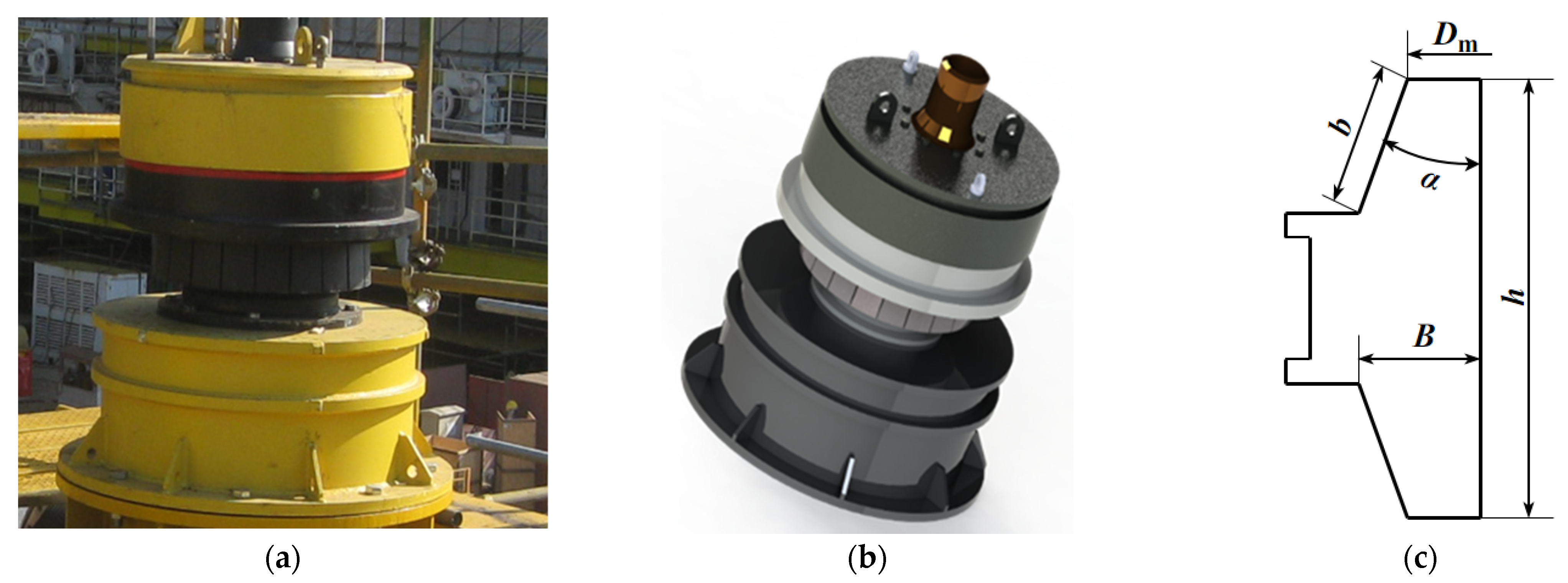







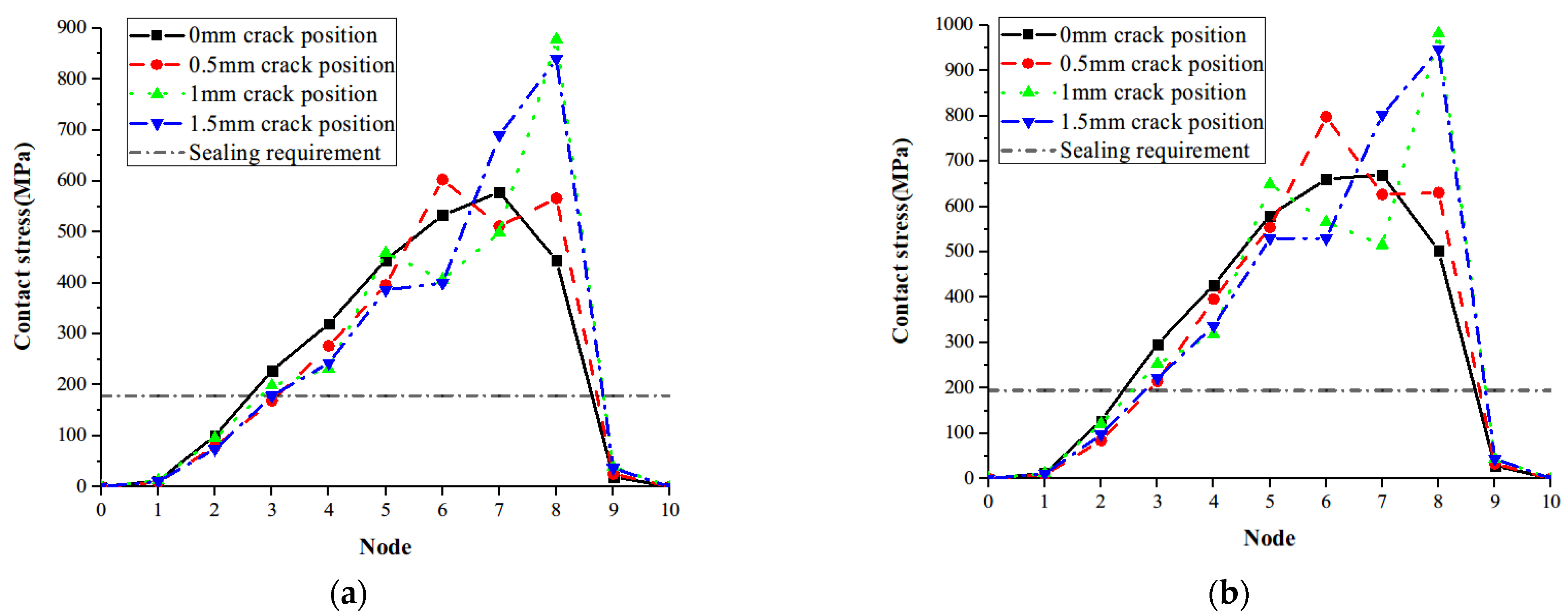
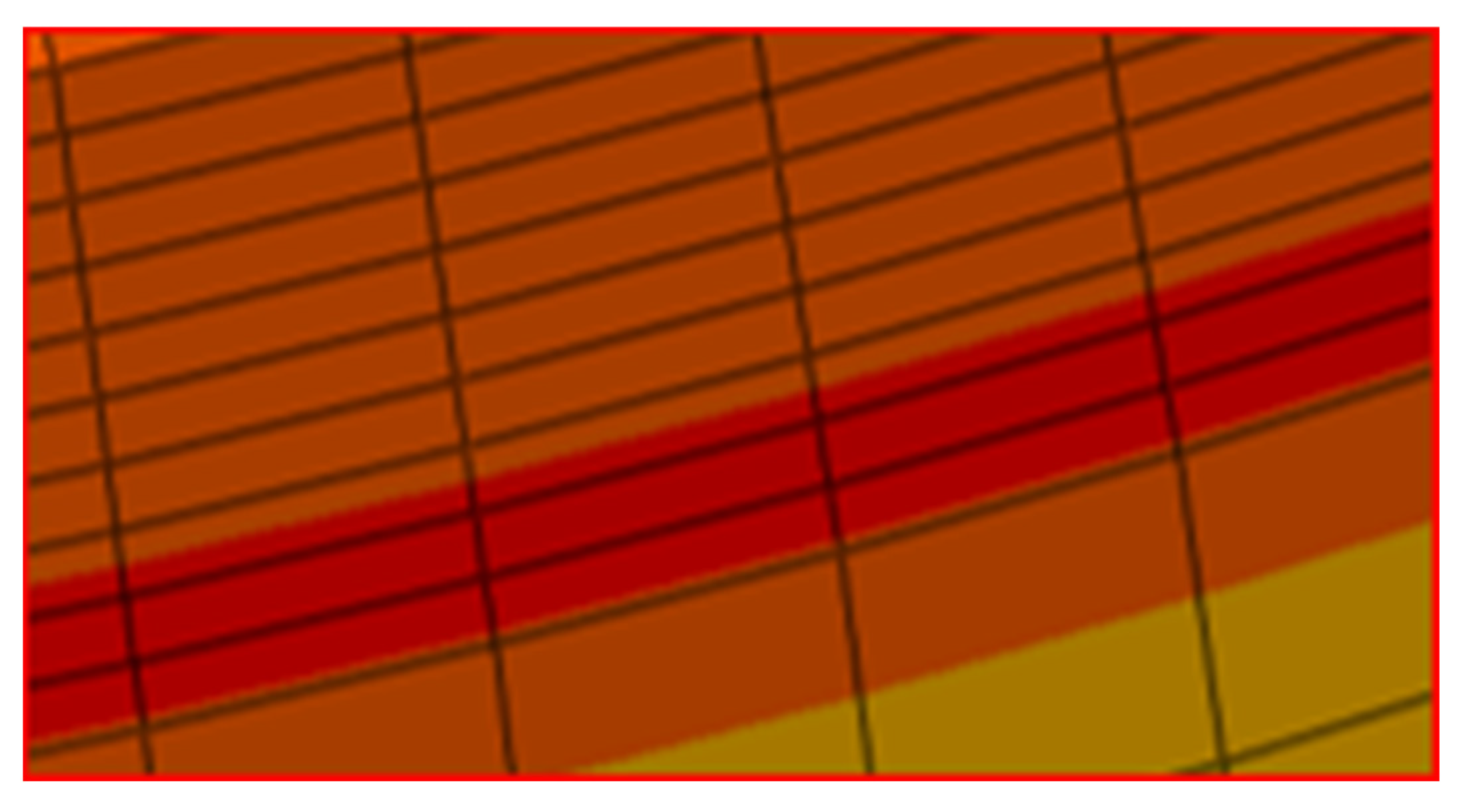




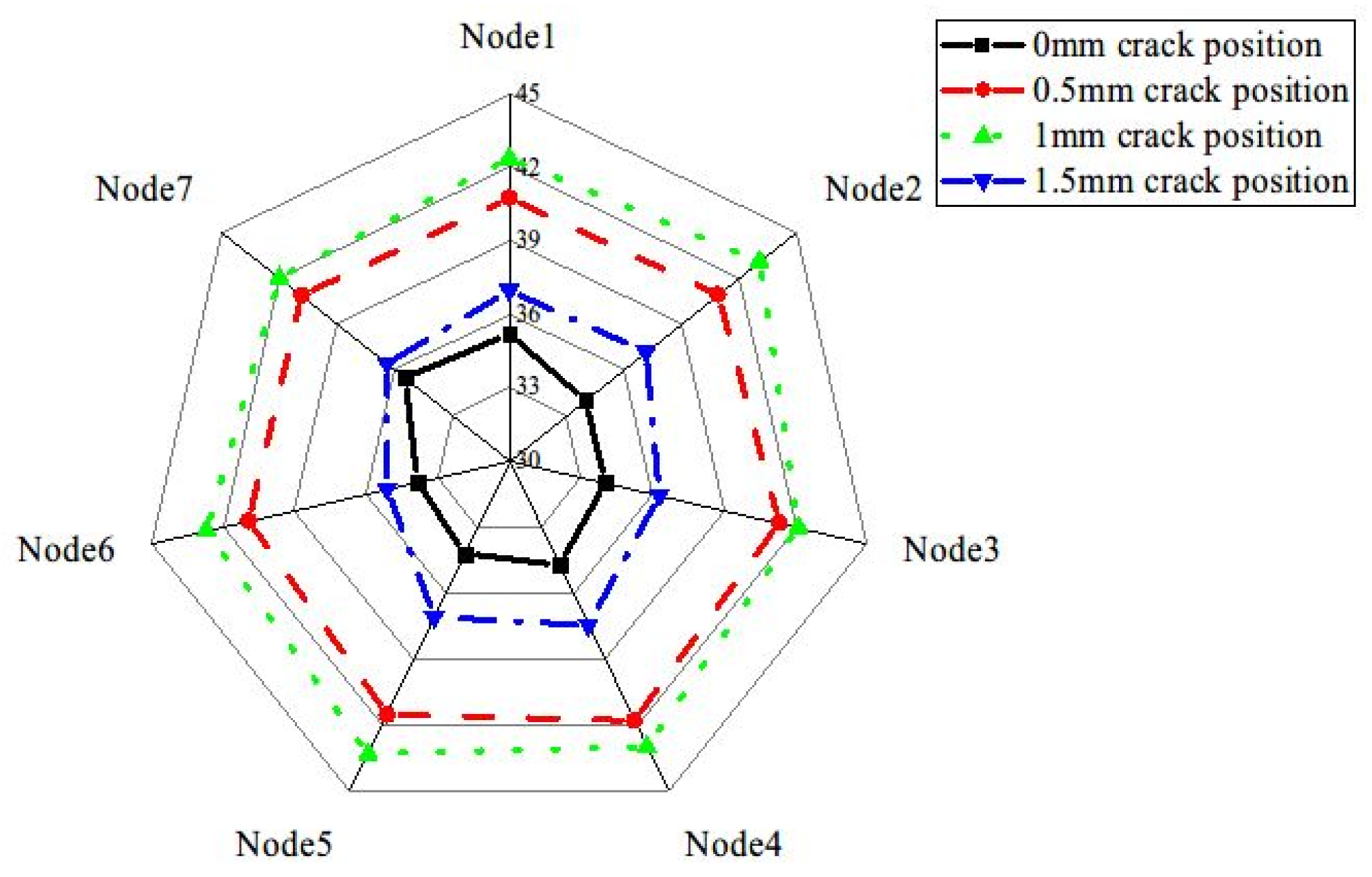
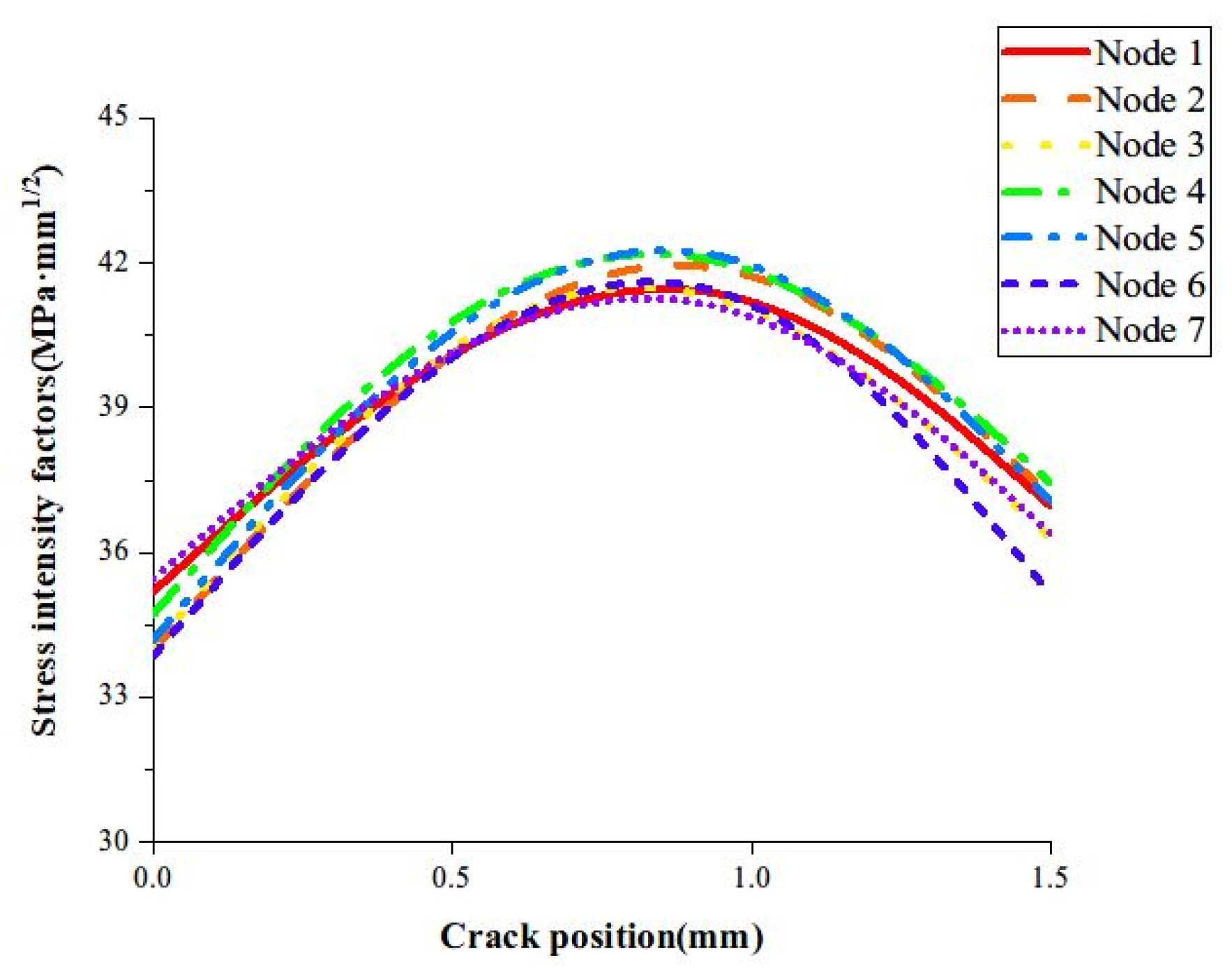
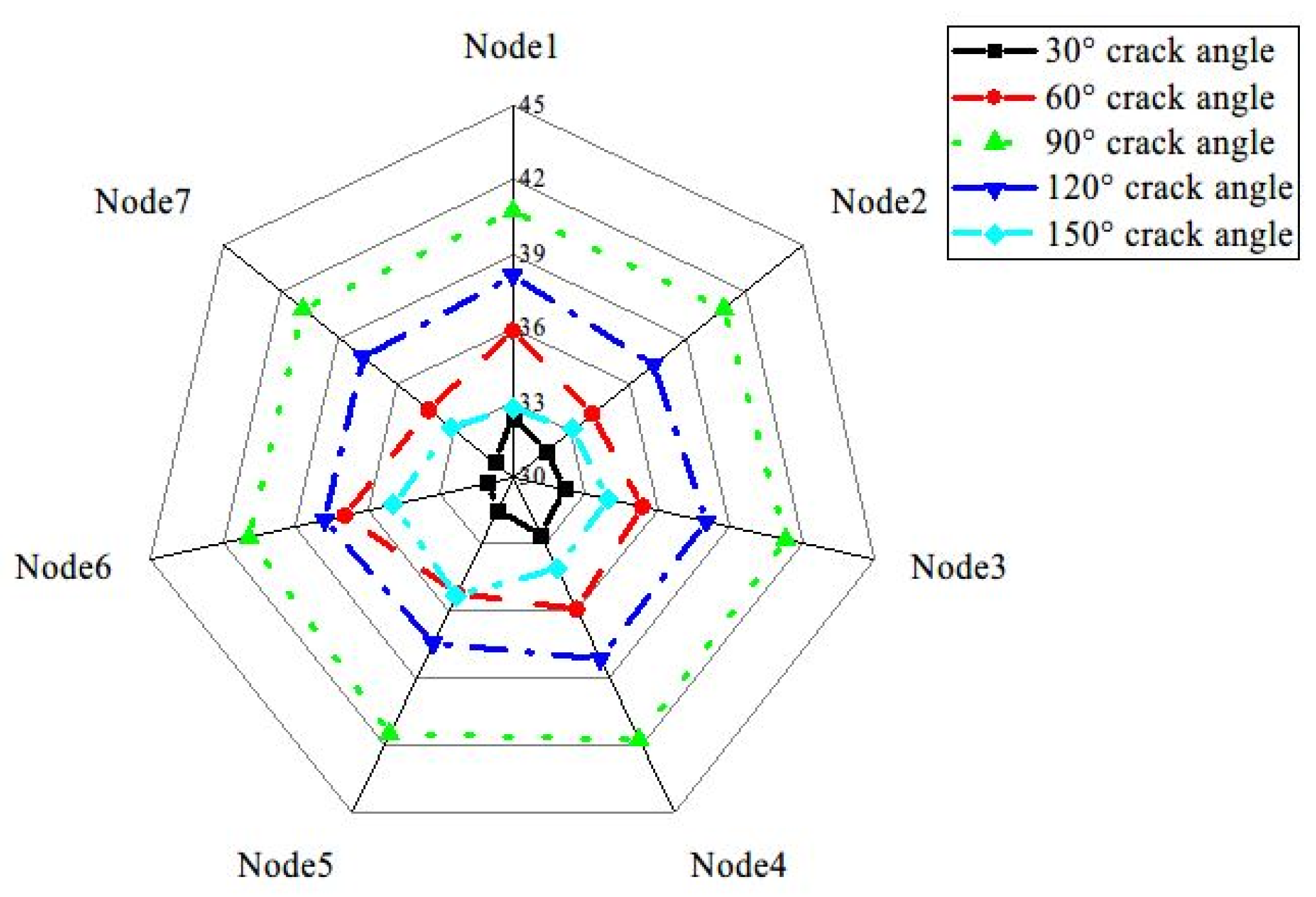
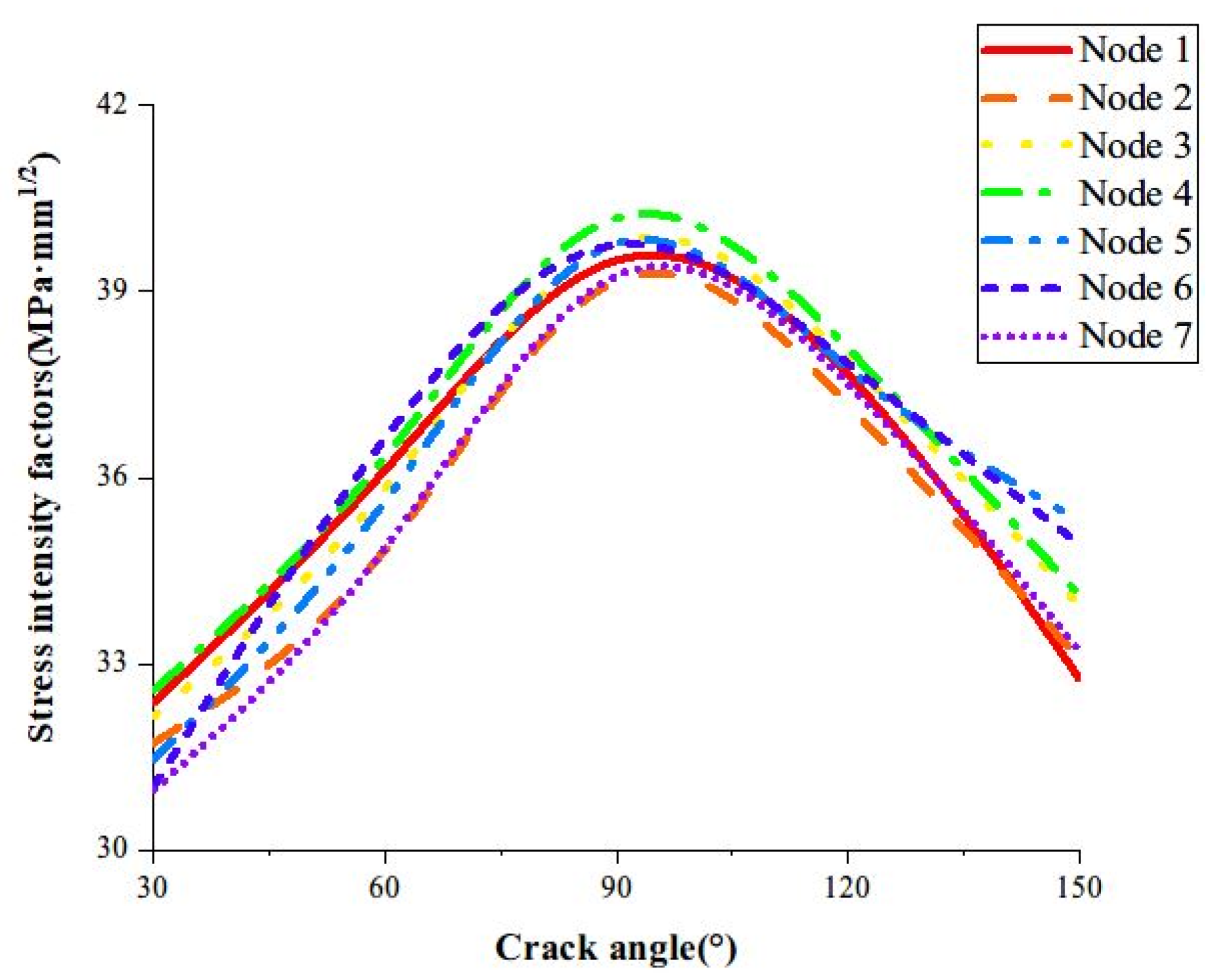
| Ri (mm) | t (mm) | a (mm) | c (mm) |
|---|---|---|---|
| 77 | 20 | 2 | 5 |
| Dm (mm) | h (mm) | B (mm) | b (mm) | α (°) |
|---|---|---|---|---|
| 164 | 76 | 20 | 28 | 23 |
| Part | Upper Hub | Lower Hub | Sealing Ring |
|---|---|---|---|
| Material | ASTM A182 F22 (75ksi) | ASTM A182 F22 (75ksi) | Inconel 625 |
| Elastic modulus/(MPa) | 210,000 | 210,000 | 200,000 |
| Passion’s ratio | 0.3 | 0.3 | 0.3 |
| Yield strength/(MPa) | 310 | 310 | 345 |
| Internal Oil Pressure p | External Seawater Pressure p’ | Preload Force F |
|---|---|---|
| 34.5 MPa | 15 MPa | 445 kN |
Publisher’s Note: MDPI stays neutral with regard to jurisdictional claims in published maps and institutional affiliations. |
© 2022 by the authors. Licensee MDPI, Basel, Switzerland. This article is an open access article distributed under the terms and conditions of the Creative Commons Attribution (CC BY) license (https://creativecommons.org/licenses/by/4.0/).
Share and Cite
Wang, Y.; Wang, C.; Liu, G.; Zhang, C.; Li, J. An Assessment Method of Sealing Performance and Stress Intensity Factors at Crack Tip of Subsea Connector Metal Sealing Rings. Energies 2022, 15, 4680. https://doi.org/10.3390/en15134680
Wang Y, Wang C, Liu G, Zhang C, Li J. An Assessment Method of Sealing Performance and Stress Intensity Factors at Crack Tip of Subsea Connector Metal Sealing Rings. Energies. 2022; 15(13):4680. https://doi.org/10.3390/en15134680
Chicago/Turabian StyleWang, Yingying, Cong Wang, Guoheng Liu, Chong Zhang, and Jianchang Li. 2022. "An Assessment Method of Sealing Performance and Stress Intensity Factors at Crack Tip of Subsea Connector Metal Sealing Rings" Energies 15, no. 13: 4680. https://doi.org/10.3390/en15134680
APA StyleWang, Y., Wang, C., Liu, G., Zhang, C., & Li, J. (2022). An Assessment Method of Sealing Performance and Stress Intensity Factors at Crack Tip of Subsea Connector Metal Sealing Rings. Energies, 15(13), 4680. https://doi.org/10.3390/en15134680





